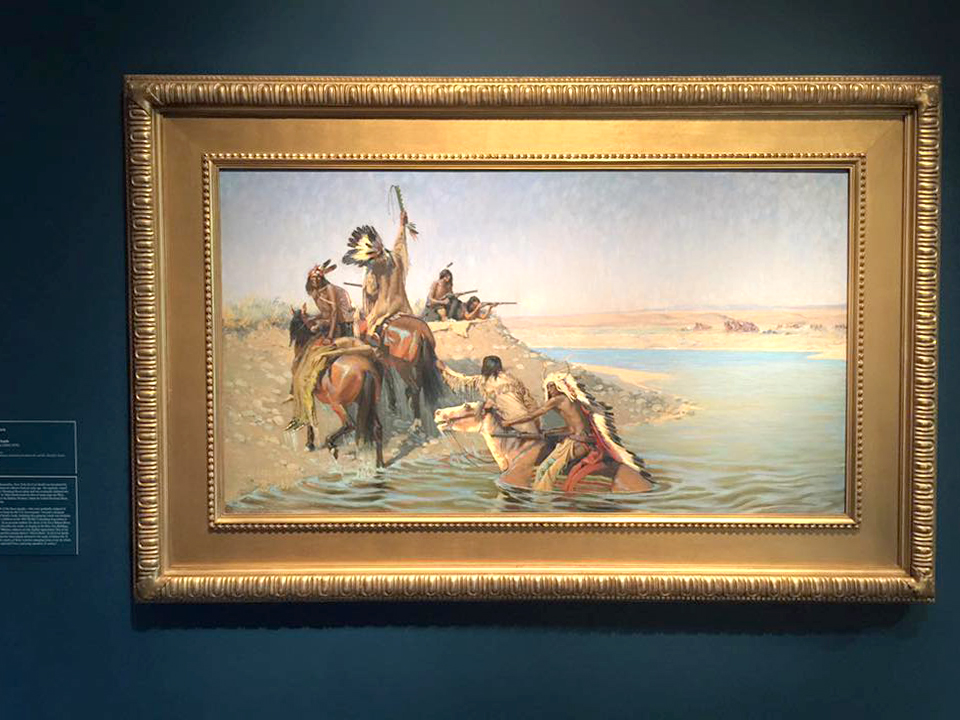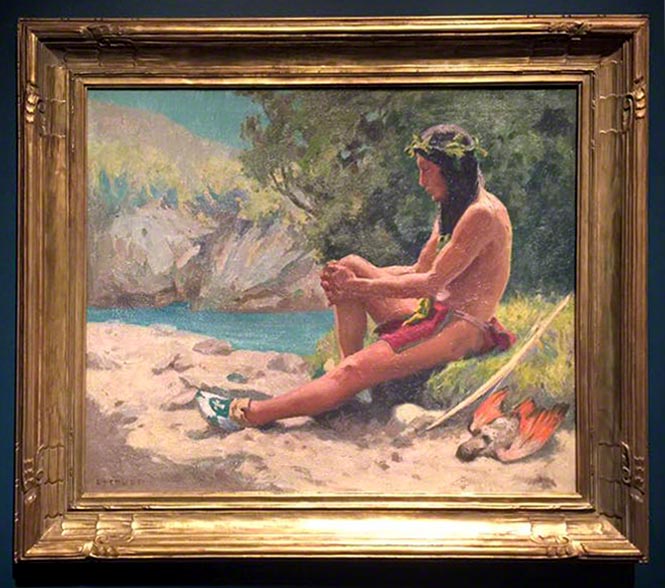BIRMINGHAM MUSEUM OF ART, ALABAMA

DE COST SMITH (1864 – 1939)
Driven Back, 1892, oil on canvas, 25-1/2" x 45-1/2". c. 1900 American painting frame; design based on traditional British Watts-style frames, gilded applied ornament on wood, stylized egg-and-dart motif outside, elegant gilded oak panel, Watts-style liner element with running leaf, astragal and flat at sight edge. Molding width: 6-3/4" "Born in Skaneateles, New York, De Cost Smith was fascinated by Native American cultures from an early age. He regularly visited the nearby Onondaga Reservation and was eventually initiated into the tribe. In 1884, Smith made his first of many trips out West, traveling to the Dakota Territory, where he visited the Great Sioux Reservation. The plight of the Sioux people–who were gradually stripped of their native lands by the U.S. Government–became a frequent subject of Smith’s work, including this painting, which was included in the art exhibition at the 1893 World’s Columbian Exposition in Chicago. In an account entitled “The Book of the Fair,” Hubert Howe Bancroft describes the works on display in the Fine Arts Building, writing, “Military subjects are but slightly represented. One of the smallest and best among them is ‘Driven Back,’ by De Cost Smith, whose time has been largely devoted to the study of Indian life. It represents a party of Sioux warriors emerging from a river by which they are separated from a pursuing squadron of cavalry.”" — Museum Permanent Collection label. Painting: Museum purchase with funds provided by Dr. and Mrs. Harold E. Simon. 1973.123

EANGER IRVING COUSE (1866 – 1936)
Dreaming, 1912, oil on canvas, 24-1/4" x 29-1/4". c. 1915 American Arts and Crafts painting frame, Newcomb-Macklin, New York/Chicago makers, metal-gilded hand-carved wood. Molding width: 4” "Raised in Saginaw, Michigan, Eanger Irving Couse’s interest in Native American cultures developed at an early age due to his interactions with the Chippewa people. He began his artistic training at the Art Institute of Chicago in 1882. The following year, he moved to New York, where he studied at the National Academy of Design. Like many of his contemporaries, Couse continued his education abroad, studying at the Académie Julian in Paris with the highly regarded academic painter William-Adolphe Bouguereau from 1886 to 1891. In 1892, Couse exhibited “The Captive,” his first painting of an Indian subject, at the Paris Salon. Couse first visited Taos, New Mexico in 1902, returning every summer for the rest of his life. Couse became a leading figure in Taos Art Colony and devoted himself to the depiction of Indian subjects, particularly the local Pueblo people. On April 14, 1913, Couse wrote to Lillian Bowron of Birmingham, Alabama, who had recently acquired “Dreaming” from the St. Louis art dealer Howard Young. He explained, “This canvas was painted by me last summer at Taos, New Mexico, & represents a young pueblo indian dreaming in the warm sunlight of that country. The Taos pueblo contains at present about 500 indians who live a happy & contented life far from the railroad & still retain their primitive manners & customs.” —Museum Collection label. Painting: Gift of Lorol Bowron Rucker in memory of her mother, Lillian Roden Bowron
